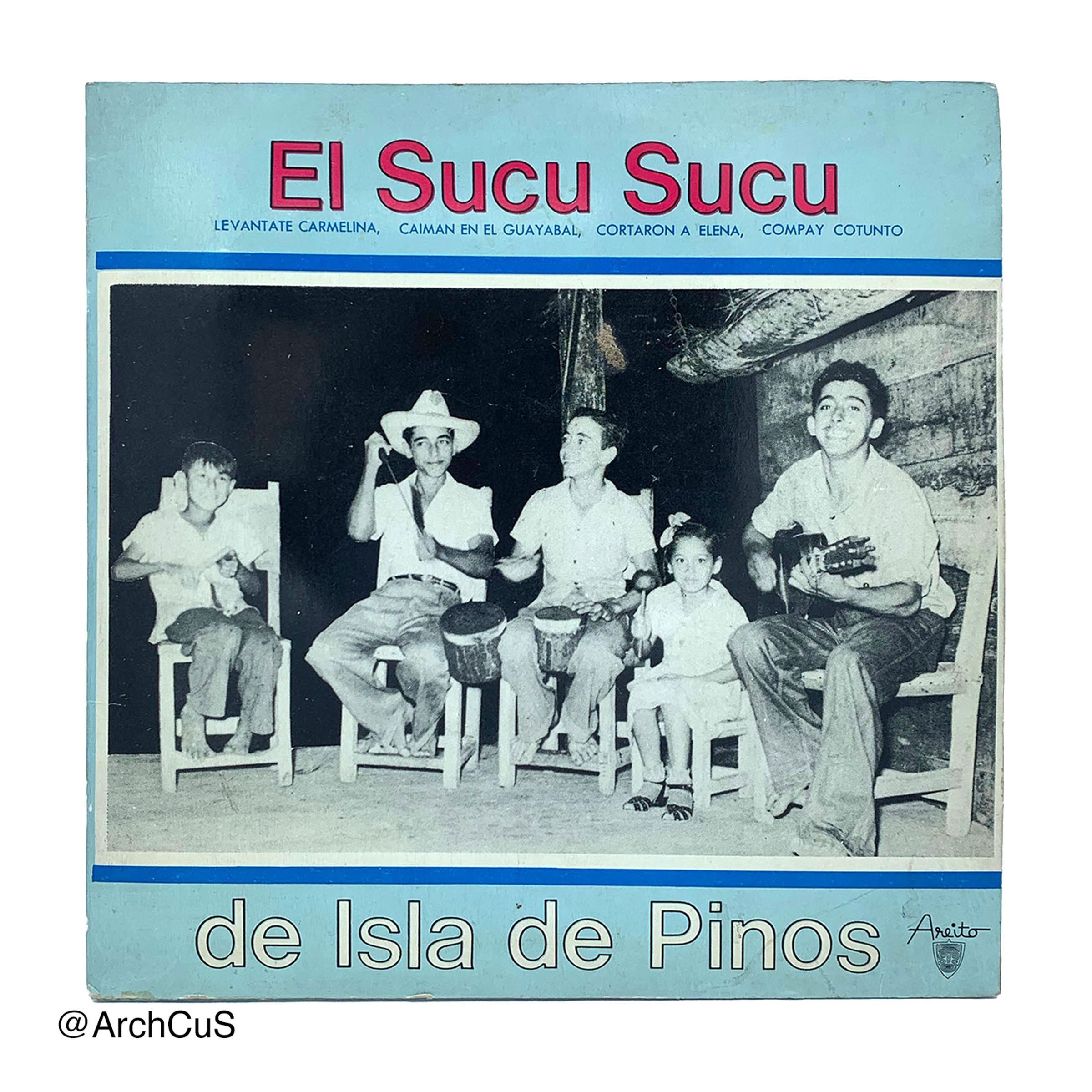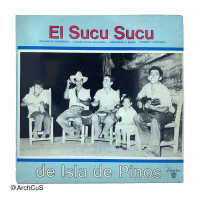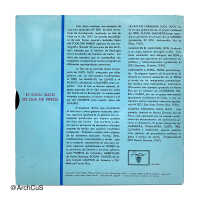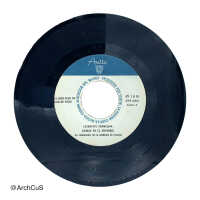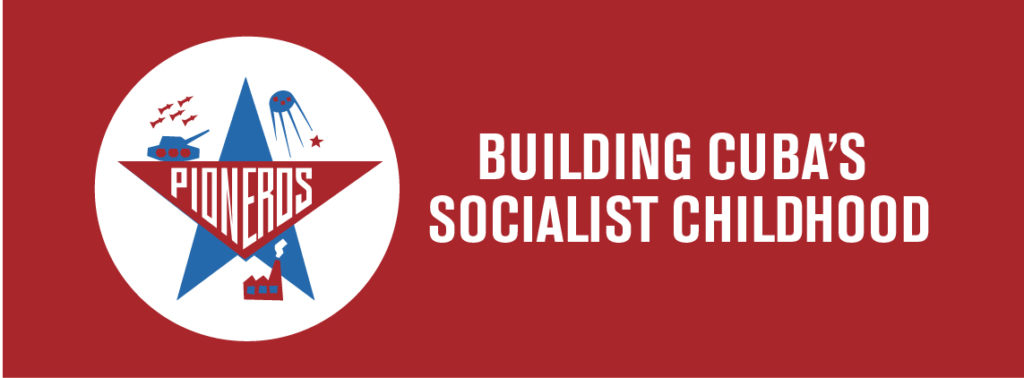Item
record, "El Sucu Sucu de Isla de Pinos"
ACS-000116
Two of the songs were recorded during a research trip of the Isle of Pines in 1967; the other two are earlier examples of sucu-sucu music as a means of comparison.
45 RPM Record
The Cabrera Arús family collection
Noelvis Diaz
Designer
Dennys Moreno
Designer
Areíto
1978
Spanish
A black and white photograph of five young people playing instruments is in the middle of the front cover, sandwiched between two light blue sections of the background. "El sucu sucu" is typed above the photograph in red ink and "de Isla de Pinos" is underneath in white ink. The titles of the four songs are typed in small blue font underneath "El sucu sucu."
Levantate carmelina
Tres cubano
Caiman en el guayabal
Cortaron a elena
Acordeon
Compay cotunto
MaribulaTumbadoraGuiroMaracas
Label
Back of album sleeve
Este disco contiene dos ejemplos de sucu-sucu grabados IN SITU durante un trabajo de investigación realizado en Isla de Pinos en el año 1967. Un estudio musicológico de esta forma musical y bailable típica del FOLKLORE PINERO aparece en una monografía titulada "El sucu-sucu de Isla de Pinos", editada por el Instituto de Etnología de la Academia de Ciencias de Cuba. Los otros dos ejemplos que se acompañan con propósitos comparativos fueron recogidos en diferentes oportunidades anteriores. La foto de la portada ilustra un conjunto de SUCU-SUCU integrado por niños pineros, con sus instrumentos tradicionales: el TRES, las MARACAS, las CLAVES y el BONGO, añadiendo un MACHETE como raspador. Con la foto se ilustran además algunos aspectos de la vida campesina antes del triunfo de la Revolución: la inadecuada vivienda campesina, el mísero vestuario y el uso del TABURETE como asiento típico del GUAJIRO. El esquema rítmico que caracteriza al sucu-sucu y otros géneros muy semejantes producidos por algunos pueblos del área del Caribe. Esto nos lleva a pensar que la presencia de elementos culturales comunes ha tenido que producir resultados semejantes. Podemos reseñar cómo algunos de los elementos musicales - forma, ritmo, combinaciones instrumentales y textos - que en su conjunto caracterizan al sucu-sucu pinero, aparece aisladamente en SONES de la provincia de Oriente y en otros géneros como PORROS de Colombia, MERENGUES de Santo Domingo, ROUND-DANCES de las islas Caimán, CALIPSOS de Jamaica y PLENAS de Puerto Rico. LEVANTATE CARMELINA, SUCU-SUCU. Esta es una grabación de un grupo incidental de TRES, CLAVES, MACHETES (como raspador) y percusión en el cuero de un TABURETE (grabación IN SITU, Jacksonville, Isla de Pinos, 1967). CAIMAN EN EL GUAYABAL, SON. Grabado a un ciego, especie de juglar criollo. Contiene elementos muy antiguos del SON y cuartetas que aparecen en cancioneros españoles y latinoamericanos (grabación IN SITU, Bayamo, Oriente, 1950). CORTARON A ELENA, PLENA puertorriqueña. En algunos lugares de la provincia de Oriente se conocen elementos de la PLENA a través de los inmigrantes puertorriqueños venidos como trabajadores azucareros. Ofrecemos este ejemplo grabado en Puerto Rico por un conjunto de ACORDEON, TIMBAL y GUIRO, por ser un grupo instrumental igualmente tradicional en Cuba, y por semejanza con los ejemplos anteriores (grabación IN SITU San Juan, Puerto Rico, 1956). COMPAY COTUNTO, SUCU-SUCU. Este ejemplo, tomado en Nueva Gerona, Isla de Pinos, está ejecutado por un conjunto profesional de descendientes de jamaicanos, pineros y caimaneros. El grupo, integrado por MARIMBULA, TUMBADORA, GUIRO, TRES, GUITARRA y MARACAS, ejecuta además otros géneros de procedencia antillano - in glesa y música de moda. (Grabación IN SITU Nueva Gerona, 1967).
Spanish
This disc contains two examples of sucu-sucu recorded IN SITU during a research work carried out on the Isle of Pines in 1967. A musicological study of this musical and dance form typical of PINERO FOLKLORE appears in a monograph entitled "El sucu-sucu de Isla de Pinos", edited by the Institute of Ethnology of the Academy of Sciences of Cuba. The other two examples that are attached for comparative purposes were collected on different previous occasions. The cover photo illustrates a group of SUCU-SUCU made up of pineros children, with their traditional instruments: the TRES, the MARACAS, the CLAVES and the BONGO, adding a MACHETE as a scraper. The photo also illustrates some aspects of peasant life before the triumph of the Revolution: the inadequate peasant housing, the miserable clothing and the use of the STOOL as a typical seat of the GUAJIRO. The rhythmic scheme that characterizes the sucu-sucu and other very similar genres produced by some peoples of the Caribbean area. This leads us to think that the presence of common cultural elements must have produced similar results. We can review how some of the musical elements - form, rhythm, instrumental combinations and texts - that as a whole characterize the sucu-sucu from Pinero, appear in isolation in SONES from the province of Oriente and in other genres such as PORROS from Colombia, MERENGUES from Santo Sunday, ROUND-DANCES from the Cayman Islands, CALYPSOS from Jamaica and PLENAS from Puerto Rico. GET UP CARMELINE, SUCU-SUCU. This is a recording of an incidental group of TRES, CLAVES, MACHETES (as a scraper) and percussion on the leather of a STOOL (IN SITU recording, Jacksonville, Isle of Pines, 1967). CAIMAN IN GUAYABAL, THEY ARE. Engraving of a blind man, a kind of Creole minstrel. It contains very old elements of the SON and quatrains that appear in Spanish and Latin American songbooks (IN SITU recording, Bayamo, Oriente, 1950). THEY CUT ELENA, FULL Puerto Rican. In some places in the province of Oriente, elements of PLENA are known through Puerto Rican immigrants who came as sugar workers. We offer this example recorded in Puerto Rico by a group of ACORDEON, TIMBAL and GUIRO, for being an equally traditional instrumental group in Cuba, and for similarity with the previous examples (recording IN SITU San Juan, Puerto Rico, 1956). COMPAY COTUNTO, SUCU-SUCU. This example, taken in Nueva Gerona, Isla de Pinos, is executed by a professional group of descendants of Jamaicans, pineros and alligators. The group, made up of MARIMBULA, TUMBADORA, GUIRO, TRES, GUITARRA and MARACAS, also performs other genres of Antillean-English origin and fashionable music. (Recording IN SITU Nueva Gerona, 1967).
18.5 cm
18.5 cm
vinyl, record case
Case
Hana Flamm
03/25/2022
Hana Flamm
08/05/2022
